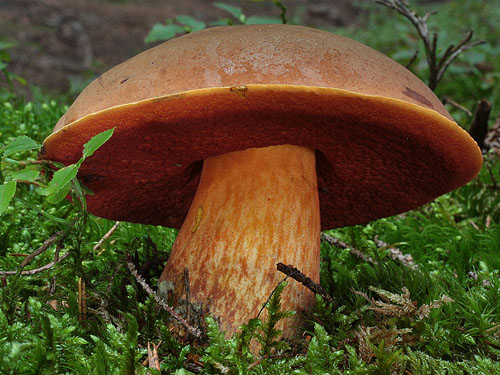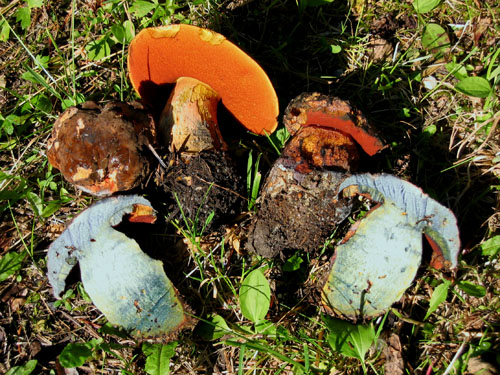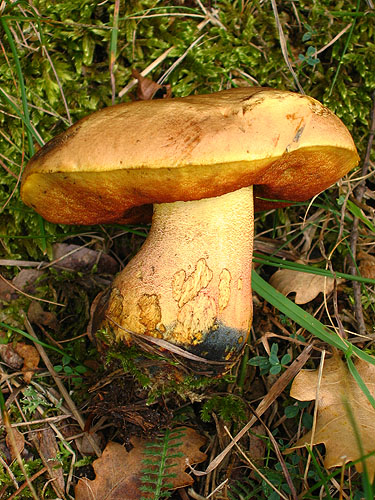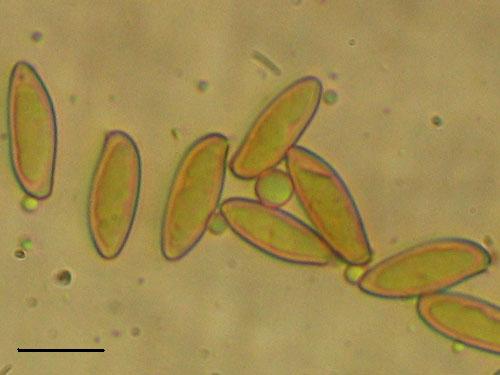Boletus L.
Recent molecular studies have shown that Boletus in its current circumscription is likely an artificial grouping and it is possible that it will be split at some point into smaller genera. Note that Boletus impolitus and Boletus depilatus for practical reasons are retained here, although there is strong evidence that they are closely related to Xerocomus subtomentosus and its allies.
Fruitbody large to medium sized, boletoid, without veil and ring. Stipe solid, with surface usually covered with granules or network. Flesh variously coloured, changing or not when exposed to air. Tubes easily separable from each other, not tearing apart. Pores usually small and rounded.
Boletus luridiformis Rostk.
Description
Cap up to 12 cm, hemispherical, later convex to flat-convex, velvety or smooth, pale brown to dark brown, sometimes dark brick coloured, darkening when bruised (var. luridiformis) or bright yellow, durty yellow to yellow orange (var. discolor), with darker rusty or brownish spots, blueing when bruised. Stipe club-shaped, sometimes bulbous or tapering towards the base, whitish, cream or yellowish, covered with dense, large, red granules or (var. luridiformis), or pale yellow to yellow with scattered fine, pale orange, orange or rusty granules, reddish vinaceous in the base (var. discolor), stipe surface blueing when bruised. Flesh lemon or pale yellow, blueing when exposed to air. Tubes lemon yellow, blueing when bruised. Pores red or orange to yellow at the cap margin, blueing when bruised. Smell not distinctive. Taste slightly acid. Spores 12–18.5 × 4–6.5 μm, ratio 2.2–3.6. Pileipellis (the cap cuticle) a trichodermium of interwoven septate hyphae of cylindrical, finely incrusted cells. Chemical reactions: hyphae of the flesh in the stipe base inamyloid with Melzer’s solution.
Variable species and two varieties are recognized here:
var. luridiformis
Habitat. Coniferous, mixed and broadleaf forests, mycorrhizal with spruce (Picea) or beech (Fagus).
Distribution. In Europe widespread and common.
Similarity. Compare with Boletus queletii.
var. discolor (Quél.) Krieglst.
Habitat. Sheltered broadleaf forests, mycorrhizal with oaks (Quercus).
Distribution. In Europe uncommon, more often encountered in south.
Similarity. Compare with Boletus pseudosulphureus, which has yellow (not orange or orange red pores). Boletus immutatus is very similar to B. luridiformis var. luridiformis, but has not blueing flesh. Boletus queletii is also somewhat similar, but differs clearly by the beetroot coloured flesh in the stipe base as well by its spores with different length/width ratio.
Note. Some recent autorities do not recognize var. discolor, reducing it to mere synonym of B. luridiformis on the base of unpublished molecular studies. It is clear that the entity in question is very close and somewhat intermediate between Boletus luridiformis and B. pseudosulphureus. However, I do feel that its distinct features may merit recognition at variety level, at least until comprehensive published study is available for this confusing group.
Boletus luridiformis was long time known under the name Boletus erythropus, but due to misfortunate confusion in the past it will have to be abandoned in favor of Boletus luridiformis.
Photographs

Typical fruitbodies of Boletus luridiformis var. luridiformis in different stages of development. (photo M. Danz)

Fully developed fruitbody of Boletus luridiformis var. luridiformis. Note the brown colour of the cap and the large granules on the stipe. (photo I. Assyova)

Fruitbody of Boletus luridiformis var. luridiformis. (photo Mikšík)

Fruitbodies of Boletus luridiformis var. luridiformis. Note the blueing of the flesh. (photo B. Assyov)

Young fruitbody of Boletus luridiformis var. discolor. Note the colours and the fine granules on the stipe. (photo B. Assyov)

Fully developed fruitbody of Boletus luridiformis var. discolor. Note again the pale colours and the fine granules on the stipe. (photo B. Assyov)

Well developed fruitbodies of Boletus luridiformis var. discolor. (photo I. Assyova)

Boletus luridiformis - spores. Scale bar = 10 μm (photo B. Assyov)
Important literature
Alessio, C.L. 1985. Boletus Dill. ex L. (sensu lato). – In: Fungi Europaei. Vol. 2. Pp. 1–705. Libreria editrice Biella Giovanna, Saronno.
Breitenbach J. & Kränzlin F. 1991. Pilze der Schweiz. Bd. 3(1). Röhrlinge und Blätterpilze. Verlag Mykologia, Luzern.
Dermek, A, Kuthan, J. & Singer, R. 1976. An interesting subspecies of Boletus erythropus (Fr. ex Fr.) Krombh. – Česká Mykologie 30: 1–2.
Engel, H., Krieglsteiner, G., Dermek, A. & Watling, R. 1983. Dickröhrlinge. Die Gattung Boletus in Europa. Verlag Heinz Engel, Weidhausen b. Coburg.
Estadès, A. & Lannoy, G. 2004. Les bolets européens. – Bulletin Mycologique et Botanique Dauphiné-Savoie 44(3): 3–79.
Hansen, L. & Knudsen, H. 1992. Nordic Macromycetes. Vol. 2. Polyporales, Boletales, Agaricales, Russulales. Nordsvamp, Copenhagen.
Galli, R. 1998. I Boleti. Atlante pratico-monographico per la determinazione dei boleti. Edinatura, Milano.
Knudsen, H. & Vesterholt, J. [eds.]. 2008. Funga Nordica. Nordsvamp, Kopenhagen.
Lannoy, G. & Estadès, A. 2001. Les Bolets. Flore mycologique d’Europe. Documents Mycologiques Mémoire Hors série no. 6. Pp. 1–163. Association d’Écologie et de Mycologie, Lille.
Muñoz, J.A. 2005. Boletus s. l. – In: Fungi Europaei. Vol. 1. Pp. 1–951. Edizioni Candusso, Alassio.
Pilát, A. & Dermek, A. 1974. Hríbovité huby. Československé hríbovité a sliziakovité huby (Boletaceae – Gomphidiaceae). Veda, Bratislava.
Reid, D.A. 1968. Fungorum Rariorum Icones Coloratae. Vol. 3. Pp. 1–34. J. Cramer, Vaduz.
Singer, R. 1967. Die Röhrlinge. II. Die Boletoideae und Strobilomycetaceae. – In: Die Pilze Mitteleuropas. Vol. 6. Pp. 1–151. Julius Klinkhardt Verlag, Bad Heilbrunn.
Watling, R. 1970. Boletaceae, Gomphidiaceae, Paxillaceae. – In: Henderson, D.M., Orton, P.D. & Watling, R. [eds]. British fungus flora. Agarics and Boleti. Vol. 1. Royal Botanic Garden, Edinburgh.
Watling, R. 2004. New combinations in Boletaceae and Gomphidiaceae (Boletales). – Edinburgh Journal of Botany 61: 41–47.
Watling, R. & Hills, A.E. 2005. Boletes and their allies (revised and enlarged edition). – In: Henderson, D.M., Orton, P.D. & Watling, R. [eds]. British Fungus Flora. Agarics and boleti. Vol. 1. Royal Botanic Garden, Edinburgh.